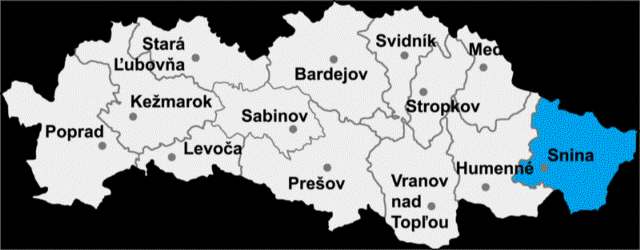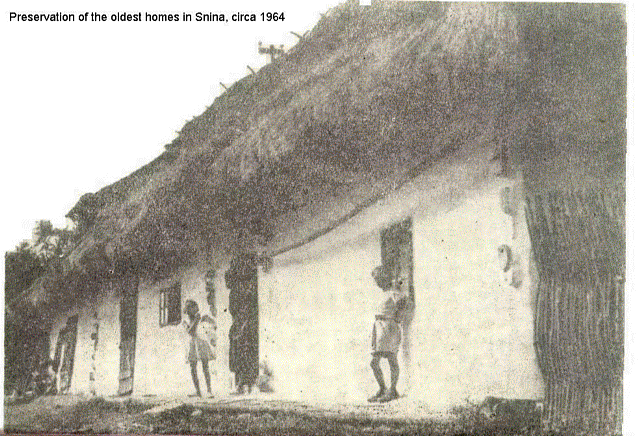The Table of Content


Family Research:









Available Help:



|
On September 17, 1875, Michal Marinič was born in Snina.

This map reflects the various districts in the Prešov Region

Snina is located on route 74, 23 km East of Humenne,
It is approximately 10km West of the Ukraine border and
roughly 8-10 km South of the border with Poland.
Snina (Szinna - Hungarian) is a medium sized city placed at the confluence of the Cirocha river and the small river Pčolinka in the valley between the Beskydy foothills and the Vihorlat mountain. It is the closest town with rail and bus connections to the Poloniny National Park.
History:
The oldest written records mentioning Snina date back to an operational (small town) is mentioned in porta records ("porta" meaning the gate to the court yard or several serf houses) beginning in 1585. In 1598 the first census of houses was done and in Snina there were 75 houses. Between 1570 and 1630, it is evident from porta records that Snina was the seat of krajňa ("krajňa" meaning the administrative district of villages). Since 1646, Snina was called "Szinna Varossa" later "Civitas Szinna" in the archives. In 1785 Snina had 195 houses and 1,430 inhabitants.
From 1321 till 1684 the area was ruled by the Drugeth Family, which came from Salerno near Naples. Later the owner of the lordship of Snina was Terézia van Dernáthová, who was the granddaughter of Žigmung Drugeth. After her death (1799) her five sons sold all the property to a businessman from Gemer – Jozef Rholl. His children improved this region until 1857. They built up iron and steel works in the Jozef valley in 1809.
From 1839 the traditional market took place in Snina four times a year. It meant development of business and trade. An iron foundry was built in the Jozef valley in 1841. There was a molded well known statue of Hercules. We can find the statue next to Snina manor-house. It is the emblem of Snina to this day. During business depressions, in 1873 iron and steel works completely vanished. Thereby this the life of dwellers of Snina and vicinity worsened rapidly and the group migration began. They left their homes and went to the USA, Canada and western Europe.
In 1876 Snina was a residence of the 10th region of the Zemplín area. The Roman Catholic classicist church from 1751 was modified at the beginning of the 19th century. A classicist Calvary in the cemetery dates from 1847. There is a manor-house from 1800 in the town set in a planned historical park, which is from the 19th century. In the courtyard of the manor-house is a public fountain with a well-known statue of Hercules from 1841. In the church's park there are monuments from World War II. There are also two military cemeteries from World War I near the town (Giglov has 130 graves of soldiers and Brehy has 153).

On May 1, 1949, the construction of the Vihorlat Enterprise began. On July 15, 1951 production started. The construction and extension of the enterprise, which was aimed at medium heavy engineering production, created further employment opportunities in construction organizations, services and trade.

Along with the development of industry and services, housing developed. Housing estates and new family houses were constructed. The largest number of flats and family houses were built here between 1975 – 1990 for families displaced by the construction of Starina reservoir seven villages had to be moved out.
Demographics:
Sninský kameň (1005m) the most visited mountain of the Vihorlat mountain range located 5 km from Snina, a protected natural formation which dominates the southern sky-line. This rock formation consists of two andesite blocks (Big and Small Stones). Nearby surroundings are prevalent with rare flowers. Marked trails from Snina lead to the top.
Morské oko is a lake located in the Vihorlat Mountains in the east of Slovakia.
Wooden churches can be found in the villages of Snina region: Ruský Potok; Uličské Krivé; Topoľa and Hrabová Roztoka.
Parihuzovce ski-lift is 14 km from Snina.

The Roman Catholic Church of Innocent Virgin Mary in Snina
  
|








